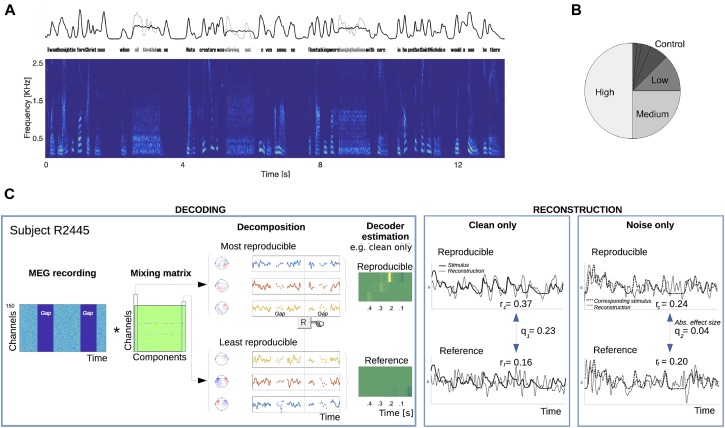FIGURE 1.
Present/absent speech stimulus protocol and cortical speech envelope reconstruction algorithm procedure. (A) Speech material from a single poem was continuously presented to 35 listeners over the course of an hour, except that every 4–5 s, some speech was replaced with spectrally matched noise (0.8 s duration; three replacements shown). This manipulation removes all critical temporal modulation for that duration. Top: example of the slow envelope of continuous speech with occasional missing speech replaced by stationary noise in black; the envelope of the removed missing speech is in gray. Bottom: spectrogram of the continuous speech with missing speech replaced by stationary noise. (B) For any participant, a verse selection was chosen to be repeated more than any other (50% of all verse presentations) and denoted as having a “high” repetition rate. Another verse selection was similarly chosen to be repeated with a “medium” repetition rate (25% of all verse presentations). Additional verses were repeated less frequently: 12.5% (“low”), 6.25%, etc. Verses presented 6.25% or less often were grouped together as “Control.” The frequency designation of verses was counterbalanced across subjects. (C) The stimulus protocol served to allow analysis of reconstruction performance for both types of response, to clean speech and to stationary noise without speech. In the decoding step, a subject’s multichannel response was decomposed into components, ordered by trial-to-trial reproducibility during speech listening (see Section “Materials and Methods”). The top three waveform components (with corresponding topographies shown) served to train a reproducible neural activity-based decoder to estimate the clean speech low-frequency envelope. Correspondingly, the bottom three components trained a reference (baseline) decoder. Separate pairs were trained according to whether the speech was present (as shown in this panel) or absent and replaced by noise (not shown). In the reconstruction step, the appropriate pair of reproducible and reference decoders were applied to the neural responses to speech or noise, respectively. Results of the envelope reconstruction algorithm are shown for a representative subject.

